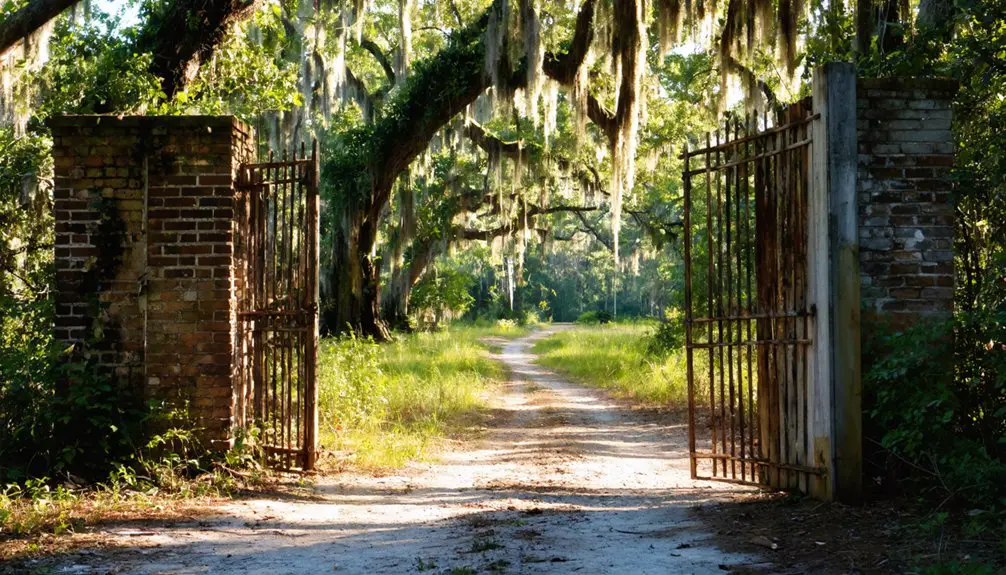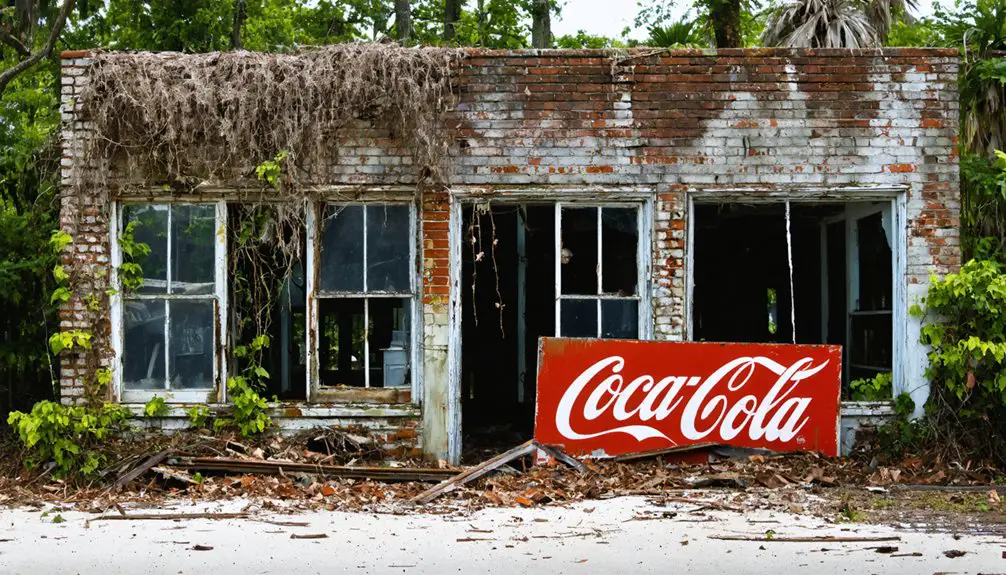You’ll find Tohopkee’s ruins near Lake Tohopekaliga in Central Florida, where this lumber mill town flourished in the late 1800s. After Native Americans first settled the area, the town grew around a sawmill operation, employing hundreds until a devastating fire in 1898. The Great Depression marked the final exodus of residents, leaving only crumbling foundations and weathered brick fragments today. The town’s mysterious past holds countless untold stories beneath its jungle-covered remains.
Key Takeaways
- Tohopkee was a 19th-century industrial settlement near Lake Tohopekaliga that transitioned from Native American territory to a sawmill-centered community.
- The town’s decline began with a devastating sawmill fire in 1898, followed by complete abandonment during the Great Depression.
- Physical remnants include crumbling roads, foundation outlines, and weathered brick fragments, now largely obscured by encroaching jungle vegetation.
- Unlike other Florida ghost towns, Tohopkee lacks official historical markers or preservation designations, with limited documentation in state archives.
- The site’s historical significance remains largely mysterious due to scarce physical evidence and documentation, complicating preservation efforts.
Origins and Native American Heritage
Long before Tohopekee became a ghost town, indigenous peoples thrived in this region of Florida for over 12,000 years.
You’ll find evidence of their Native traditions in the shell mounds they built near wetlands as far back as 3000 B.C., where they gathered shellfish and fished in the rich waters.
The area’s cultural resilience became evident when the Seminoles, originally Creek migrants from Georgia and Alabama, merged with local tribes like the Jobe and Tequesta in the 18th century.
These native peoples utilized dugout canoes for trading with neighboring tribes across the region’s waterways.
They established strong communities around what would become Tohopekee, adapting to the challenging landscape.
Their legacy lives on in local place names and archaeological sites throughout Palm Beach County, where their descendants continue to preserve their heritage despite centuries of pressure and conflict.
The indigenous peoples demonstrated remarkable survival skills by living off the land, using natural resources from the Everglades to sustain their communities.
Early Settlement and Development
The Spanish arrival in Florida marked a new chapter for the land that would become Tohopekee. When Juan Ponce de León first explored Florida in 1513, you’d have witnessed the beginning of dramatic changes to the region’s landscape.
Early settler interactions proved challenging, as demonstrated by the failed 1521 settlement attempt that cost Ponce de León his life at the hands of the Calusa Indians. The native Timucua speakers numbered around 150,000 when Europeans first arrived.
Ponce de León’s tragic 1521 settlement attempt, ending in his death by Calusa warriors, highlighted the dangers early colonizers faced in Florida.
You’ll find that the Spanish eventually succeeded through their mission systems, which converted natives to Christianity while securing essential labor for agriculture. The colonists built the impressive Castillo de San Marcos from 1672 to 1695, providing crucial protection for their settlements.
The settlements that survived, like St. Augustine in 1565, relied heavily on strategic positioning near fresh water and fertile soils. These early colonies also depended on coastal access for fishing and trade, establishing patterns of development that would influence Tohopekee’s future location and growth.
Economic Growth and Agricultural Legacy
While early settlers faced initial agricultural challenges, Ochopee’s farming industry flourished after the 1928 completion of the Tamiami Trail. Similar to the sugarcane harvesting methods that evolved from manual labor to mechanical combines in Palm Beach County, the region’s agricultural innovation was best exemplified by Edgar S. Gaunt’s expansion from 250 acres to over 3,000 acres of productive farmland, demonstrating remarkable economic resilience in Florida’s challenging environment. Native Indian tribes had established successful farming practices in the region long before European settlement.
You’ll find that Ochopee’s agricultural legacy shaped the region through:
- Diverse crop cultivation including tomatoes, peas, peppers, and potatoes
- Employment opportunities supporting nearly 1,000 workers by the 1940s
- Development of essential infrastructure like packing houses and general stores
- Integration of multiple ventures including logging and rum distillation
The J.T. Gaunt Company’s success story exemplifies how agricultural enterprise transformed this frontier town into a thriving economic hub, even if temporary.
Causes Behind the Town’s Decline
Despite its early agricultural success, Tohopkee’s decline began in the mid-1950s through a perfect storm of economic and environmental challenges.
The town’s economic vulnerability became apparent when mechanization reduced agricultural jobs, while its single-industry dependence left it exposed to market fluctuations. You’ll find that the railroad’s abandonment and the interstate bypass in the 1960s effectively cut off Tohopkee’s commercial lifeline. Many homeowners faced soaring insurance premiums reaching $7,000 to $9,000 annually, forcing them to abandon their properties.
Environmental degradation hit particularly hard in the following decades. Rising insurance costs from increased hurricane risks and flooding made homeownership unsustainable for many residents. Like many inland Florida communities facing significant population losses, Tohopkee struggled to maintain basic infrastructure and services for its dwindling population.
Present-Day Remnants and Preservation
You’ll find Tohopkee’s physical traces scattered across its former townsite, including crumbling roads, foundation outlines, and weathered brick fragments that reveal the original town layout.
Similar to Florida’s early 1900s boom, many structures were hastily built then abandoned when the town failed to thrive.
The jungle encroachment has steadily consumed much of the site, exemplifying the ongoing battle between human structures and Florida’s natural elements.
The area’s lack of formal preservation programs has left these remnants in a state of arrested decay, with natural overgrowth increasingly obscuring historic features.
While informal documentation exists through ghost town enthusiasts’ photographs and notes, the site remains without official historical recognition or protected status.
Physical Traces Today
In modern times, physical remnants of Tohopkee reveal a complex array of deteriorating structures and altered landscapes across multiple sites.
You’ll find the architectural significance deeply embedded in scattered brick ruins and foundations that mark this once-thriving settlement’s industrial past.
Your visitor experience at Tohopkee’s remaining sites includes:
- Weathered brick roads leading to partially collapsed structural frames
- The historic Disston Sugar Mill ruins, showcasing early Florida’s industrial heritage
- Evidence of altered waterways and canal systems that changed Lake Tohopekaliga’s levels
- Stripped and deteriorating residential structures with exposed interior frames
Natural erosion and limited preservation efforts continue to threaten these remaining traces of Tohopkee’s history, while accessibility constraints make both casual visits and formal archaeological documentation increasingly challenging.
Conservation Area Integration
While historic Tohopekee’s structural remains continue to deteriorate, the surrounding conservation area has undergone extensive habitat restoration efforts led by the Florida Fish and Wildlife Conservation Commission.
You’ll find that the FWC’s treatments around Lake Tohopekaliga focus on enhancing aquatic habitats and supporting native species populations.
The area’s ecological resilience is strengthened through the South Florida Water Management District’s water reservation system, which protects approximately 172,500 acres including East Lake Tohopekaliga.
Through careful monitoring and regulation, these conservation initiatives have helped rehabilitate native plant communities that were previously degraded across 50,000 acres.
The restoration work includes replanting vegetation to stabilize sediments, improve water clarity, and create complex habitats for local wildlife, all while maintaining compliance with federal and state environmental protection standards.
Historical Documentation Status
Despite extensive searches through Florida’s historical archives, Tohopkee‘s physical remnants and documented history remain remarkably sparse compared to other regional ghost towns.
The historical significance of this settlement faces significant documentation challenges, with most knowledge derived from oral traditions rather than concrete records.
You’ll find these key limitations in Tohopkee’s historical documentation:
- No surviving architectural structures or visible infrastructure
- Absence of official historical markers or preservation designations
- Limited archival materials compared to similar ghost towns like Ochopee
- Reliance primarily on local folklore and archaeological inferences
While underwater graveyards in Lake Okeechobee hint at early settlements, you won’t find conclusive evidence linking these directly to Tohopkee.
The town’s story, like many vanished Florida settlements, remains largely a mystery waiting to be uncovered.
Historical Impact on Florida’s Rural Landscape

Through its dramatic rise and fall, Tohopekee exemplified the volatile nature of Florida’s rural development during the late 19th century.
You’ll find its cultural significance deeply rooted in the region’s transformation from Native American territory to an industrial hub, particularly through its sawmill operations near Lake Tohopekaliga.
The town’s regional influences mirrored broader patterns of development and decline that you’d recognize across Florida’s rural landscape.
When Tohopekee’s primary sawmill burned in 1898, you would’ve witnessed a chain reaction that devastated the local economy.
Combined with recurring floods and the shift from steamboat to railroad transportation, these changes permanently altered settlement patterns.
During the Great Depression, you’d have seen the final exodus of residents, leaving Tohopekee as a reflection of the fragile nature of single-industry towns.
Frequently Asked Questions
Are There Any Known Photographs or Maps of Tohopkee During Its Peak?
You won’t find reliable photographic evidence or detailed historical maps of Tohopkee during its peak – available records don’t show published collections, though local archives might hold undiscovered documentation.
What Specific Crops Were Predominantly Grown in Tohopkee’s Agricultural Heyday?
You’d think they grew gold bars given how little we understand! Based on regional patterns, cotton production likely dominated early on, while citrus farming emerged as settlers adapted to Florida’s climate.
Did Any Notable Historical Figures or Events Connect With Tohopkee?
You won’t find any notable residents or historical significance tied directly to this settlement – records don’t reveal any famous personalities or landmark events that impacted the broader American story.
How Many Residents Lived in Tohopkee at Its Largest Population?
You’ll find Tohopkee’s population history peaked at approximately 100 residents during its lumber town heyday, though precise records aren’t available to confirm exact population dynamics during this period.
Were There Any Schools or Churches Established in Tohopkee?
You won’t find documented school history or church activities in Tohopkee’s records. While small Florida settlements often had these institutions, there’s no clear evidence that either was formally established here.
References
- https://www.nps.gov/bicy/learn/historyculture/ochopee.htm
- https://freepages.history.rootsweb.com/~gtusa/usa/fl.htm
- https://www.journaloffloridastudies.org/0102ghosttowns.html
- https://www.youtube.com/watch?v=ov9YSsKtbDs
- https://en.wikipedia.org/wiki/List_of_ghost_towns_in_Florida
- https://www.thepalmbeaches.com/blog/native-americans-first-people-palm-beaches
- https://www.youtube.com/watch?v=Ev6wykAWsyA
- https://research.ufl.edu/publications/explore/v03n2/indians.html
- https://www.visitflorida.com/travel-ideas/articles/arts-history-native-american-culture-heritage-florida/
- https://en.wikipedia.org/wiki/Indigenous_peoples_of_Florida



